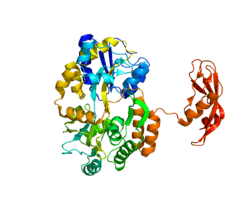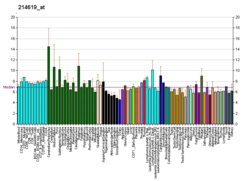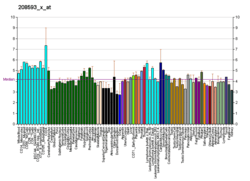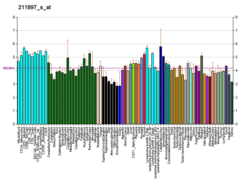Corticotropin-releasing hormone receptor 1
Corticotropin-releasing hormone receptor 1 (CRHR1) is a protein, also known as CRF1, with the latter (CRF1) now being the IUPHAR-recommended name.[5] In humans, CRF1 is encoded by the CRHR1 gene.[6][7]
Structure
The human CRHR1 gene contains 14 exons over 20 kb of DNA, and its full gene product is a peptide composed of 444 amino acids.[8] Excision of exon 6 yields in the mRNA for the primary functional CRF1,[8] which is a peptide composed of 415 amino acids, arranged in seven hydrophobic alpha-helices.[9][10]
The CRHR1 gene is alternatively spliced into a series of variants.[8][11] These variants are generated through deletion of one of the 14 exons, which in some cases causes a frame-shift in the open reading frame, and encode corresponding isoforms of CRF1.[8][10] Though these isoforms have not been identified in native tissues, the mutations of the splice variants of mRNA suggest the existence of alternate CRF receptors, with differences in intracellular loops or deletions in N-terminus or transmembrane domains.[10] Such structural changes suggest that the alternate CRF1 receptors have different degrees of capacity and efficiency in binding CRF and its agonists.[8][10][11] Though the functions of these CRF1 receptors is yet unknown, they are suspected to be biologically significant.[10]
CRF1 is 70% homologous with the second human CRF receptor family, CRF2; the greatest divergence between the two lies at the N-terminus of the protein.[8][10]
Mechanism of activation
CRF1 is activated through the binding of CRF or a CRF-agonist.[8][9][10] The ligand binding and subsequent receptor conformational change depends on three different sites in the second and third extracellular domains of CRF1.[10]
In the majority of tissues, CRF1 is coupled to a stimulatory G-protein that activates the adenylyl cyclase signaling pathway, and ligand-binding triggers an increase in cAMP levels.[8][10] However, the signal can be transmitted along multiple signal transduction cascades, according to the structure of the receptor and the region of its expression.[10] Alternate signaling pathways activated by CRF1 include PKC and MAPK.[8] This wide variety of cascades suggests that CRF1 mediates tissue-specific responses to CRF and CRF-agonists.[8][10]
Tissue distribution
CRF1 is expressed widely throughout both the central and peripheral nervous systems.[10] In the central nervous system, CRF1 is particularly found in the cortex, cerebellum, amygdala, hippocampus, olfactory bulb, ventral tegmental area, brainstem areas, and pituitary.[8][9][12] In the pituitary, CRF1 stimulation triggers the activation of the POMC gene, which in turn causes the release of ACTH and β-endorphins from the anterior pituitary.[8] In the peripheral nervous system, CRF1 is expressed at low levels in a wide variety of tissues, including the skin, spleen, heart, liver, adipose tissue, placenta, ovary, testis, and adrenal gland.[8][9][11]
In CRF1 knockout mice, and mice treated with a CRF1 antagonist, there is a decrease in anxious behavior and a blunted stress response, suggesting that CRF1 mechanisms are anxiogenic.[8][12] However, the effect of CRF1appears to be regionally specific and cell-type specific, likely due to the wide variety of cascades and signaling pathways activated by the binding of CRF or CRF-agonists.[12] In the central nervous system, CRF1 activation mediates fear learning and consolidation in the extended amygdala, stress-related modulation of memory formation in the hippocampus, and brainstem regulation of arousal.[12]
Function
The corticotropin-releasing hormone receptor binds corticotropin-releasing hormone, a potent mediator of endocrine, autonomic, behavioral, and immune responses to stress.[13]
CRF1 receptors in mice mediate ethanol enhancement of GABAergic synaptic transmission.[14]
Evolution
Corticotrophin releasing hormone (CRH) evolved ~500 million years ago in an organism that subsequently gave rise to both chordates and arthropods.[15] The binding site for this was single CRH like receptor. In vertebrates this gene was duplicated leading to the extant CRH1 and CRH2 forms. Additionally four paralogous ligands developed including CRH, urotensin-1/urocortin, urocortin II and urocortin III.
Clinical significance
Variations in the CRHR1 gene is associated with enhanced response to inhaled corticosteroid therapy in asthma.[16]
CRF1 triggers cells to release hormones that are linked to stress and anxiety [original reference missing]. Hence CRF1 receptor antagonists are being actively studied as possible treatments for depression and anxiety.[17][18]
Variations in CRHR1 are associated with persistent pulmonary hypertension of the newborn.[19]
Interactions
Corticotropin-releasing hormone receptor 1 has been shown to interact with Corticotropin-releasing hormone[10][20] and urocortin.[21]
See also
References
- ENSG00000120088, ENSG00000278232 GRCh38: Ensembl release 89: ENSG00000276191, ENSG00000120088, ENSG00000278232 - Ensembl, May 2017
- GRCm38: Ensembl release 89: ENSMUSG00000018634 - Ensembl, May 2017
- "Human PubMed Reference:". National Center for Biotechnology Information, U.S. National Library of Medicine.
- "Mouse PubMed Reference:". National Center for Biotechnology Information, U.S. National Library of Medicine.
- Hauger RL, Grigoriadis DE, Dallman MF, Plotsky PM, Vale WW, Dautzenberg FM (March 2003). "International Union of Pharmacology. XXXVI. Current status of the nomenclature for receptors for corticotropin-releasing factor and their ligands". Pharmacological Reviews. 55 (1): 21–6. doi:10.1124/pr.55.1.3. PMID 12615952.
- Polymeropoulos MH, Torres R, Yanovski JA, Chandrasekharappa SC, Ledbetter DH (July 1995). "The human corticotropin-releasing factor receptor (CRHR) gene maps to chromosome 17q12-q22". Genomics. 28 (1): 123–4. doi:10.1006/geno.1995.1118. PMID 7590738.
- Chen R, Lewis KA, Perrin MH, Vale WW (October 1993). "Expression cloning of a human corticotropin-releasing-factor receptor". Proceedings of the National Academy of Sciences of the United States of America. 90 (19): 8967–71. doi:10.1073/pnas.90.19.8967. PMC 47482. PMID 7692441.
- Hillhouse EW, Grammatopoulos DK (May 2006). "The molecular mechanisms underlying the regulation of the biological activity of corticotropin-releasing hormone receptors: implications for physiology and pathophysiology". Endocrine Reviews. 27 (3): 260–86. doi:10.1210/er.2005-0034. PMID 16484629.
- Hauger RL, Grigoriadis DE, Dallman MF, Plotsky PM, Vale WW, Dautzenberg FM (March 2003). "International Union of Pharmacology. XXXVI. Current status of the nomenclature for receptors for corticotropin-releasing factor and their ligands". Pharmacological Reviews. 55 (1): 21–6. doi:10.1124/pr.55.1.3. PMID 12615952.
- Grammatopoulos DK, Dai Y, Randeva HS, Levine MA, Karteris E, Easton AJ, Hillhouse EW (December 1999). "A novel spliced variant of the type 1 corticotropin-releasing hormone receptor with a deletion in the seventh transmembrane domain present in the human pregnant term myometrium and fetal membranes". Molecular Endocrinology. 13 (12): 2189–202. doi:10.1210/mend.13.12.0391. PMID 10598591.
- Paschos KA, Chouridou E, Koureta M, Lambropoulou M, Kolios G, Chatzaki E (April 2013). "The corticotropin releasing factor system in the liver: expression, actions and possible implications in hepatic physiology and pathology". Hormones. 12 (2): 236–45. doi:10.14310/horm.2002.1407. PMID 23933692.
- Henckens MJ, Deussing JM, Chen A (October 2016). "Region-specific roles of the corticotropin-releasing factor-urocortin system in stress". Nature Reviews. Neuroscience. 17 (10): 636–51. doi:10.1038/nrn.2016.94. PMID 27586075.
- "Entrez Gene: CRHR1 corticotropin releasing hormone receptor 1".
- Nie Z, Schweitzer P, Roberts AJ, Madamba SG, Moore SD, Siggins GR (March 2004). "Ethanol augments GABAergic transmission in the central amygdala via CRF1 receptors". Science. 303 (5663): 1512–4. doi:10.1126/science.1092550. PMID 15001778.
- Lovejoy D, Chang B, Lovejoy N, Del Castillo J (2014) Origin and functional evolution of the corticotrophin-releasing hormone receptors. J Mol Endocrinol
- Tantisira KG, Lake S, Silverman ES, Palmer LJ, Lazarus R, Silverman EK, Liggett SB, Gelfand EW, Rosenwasser LJ, Richter B, Israel E, Wechsler M, Gabriel S, Altshuler D, Lander E, Drazen J, Weiss ST (July 2004). "Corticosteroid pharmacogenetics: association of sequence variants in CRHR1 with improved lung function in asthmatics treated with inhaled corticosteroids". Human Molecular Genetics. 13 (13): 1353–9. doi:10.1093/hmg/ddh149. PMID 15128701.
- Kehne JH (June 2007). "The CRF1 receptor, a novel target for the treatment of depression, anxiety, and stress-related disorders". CNS & Neurological Disorders Drug Targets. 6 (3): 163–82. doi:10.2174/187152707780619344. PMID 17511614.
- Ising M, Holsboer F (December 2007). "CRH-sub-1 receptor antagonists for the treatment of depression and anxiety". Experimental and Clinical Psychopharmacology. 15 (6): 519–28. doi:10.1037/1064-1297.15.6.519. PMID 18179304.
- Byers HM, Dagle JM, Klein JM, Ryckman KK, McDonald EL, Murray JC, Borowski KS (February 2012). "Variations in CRHR1 are associated with persistent pulmonary hypertension of the newborn". Pediatric Research. 71 (2): 162–7. doi:10.1038/pr.2011.24. PMC 3718388. PMID 22258127.
- Gottowik J, Goetschy V, Henriot S, Kitas E, Fluhman B, Clerc RG, Moreau JL, Monsma FJ, Kilpatrick GJ (October 1997). "Labelling of CRF1 and CRF2 receptors using the novel radioligand, [3H]-urocortin". Neuropharmacology. 36 (10): 1439–46. doi:10.1016/S0028-3908(97)00098-1. PMID 9423932.
- Donaldson CJ, Sutton SW, Perrin MH, Corrigan AZ, Lewis KA, Rivier JE, Vaughan JM, Vale WW (May 1996). "Cloning and characterization of human urocortin". Endocrinology. 137 (5): 2167–70. doi:10.1210/en.137.5.2167. PMID 8612563.
Further reading
- Taché Y, Martinez V, Wang L, Million M (April 2004). "CRF1 receptor signaling pathways are involved in stress-related alterations of colonic function and viscerosensitivity: implications for irritable bowel syndrome". British Journal of Pharmacology. 141 (8): 1321–30. doi:10.1038/sj.bjp.0705760. PMC 1574904. PMID 15100165.
- McLean M, Bisits A, Davies J, Woods R, Lowry P, Smith R (May 1995). "A placental clock controlling the length of human pregnancy". Nature Medicine. 1 (5): 460–3. doi:10.1038/nm0595-460. PMID 7585095.
- Polymeropoulos MH, Torres R, Yanovski JA, Chandrasekharappa SC, Ledbetter DH (July 1995). "The human corticotropin-releasing factor receptor (CRHR) gene maps to chromosome 17q12-q22". Genomics. 28 (1): 123–4. doi:10.1006/geno.1995.1118. PMID 7590738.
- Chen R, Lewis KA, Perrin MH, Vale WW (October 1993). "Expression cloning of a human corticotropin-releasing-factor receptor". Proceedings of the National Academy of Sciences of the United States of America. 90 (19): 8967–71. doi:10.1073/pnas.90.19.8967. PMC 47482. PMID 7692441.
- Ross PC, Kostas CM, Ramabhadran TV (December 1994). "A variant of the human corticotropin-releasing factor (CRF) receptor: cloning, expression and pharmacology". Biochemical and Biophysical Research Communications. 205 (3): 1836–42. doi:10.1006/bbrc.1994.2884. PMID 7811272.
- Opdenakker G, Fiten P, Nys G, Froyen G, Van Roy N, Speleman F, Laureys G, Van Damme J (May 1994). "The human MCP-3 gene (SCYA7): cloning, sequence analysis, and assignment to the C-C chemokine gene cluster on chromosome 17q11.2-q12". Genomics. 21 (2): 403–8. doi:10.1006/geno.1994.1283. PMID 7916328.
- Vita N, Laurent P, Lefort S, Chalon P, Lelias JM, Kaghad M, Le Fur G, Caput D, Ferrara P (November 1993). "Primary structure and functional expression of mouse pituitary and human brain corticotrophin releasing factor receptors". FEBS Letters. 335 (1): 1–5. doi:10.1016/0014-5793(93)80427-V. PMID 8243652.
- Donaldson CJ, Sutton SW, Perrin MH, Corrigan AZ, Lewis KA, Rivier JE, Vaughan JM, Vale WW (May 1996). "Cloning and characterization of human urocortin". Endocrinology. 137 (5): 2167–70. doi:10.1210/en.137.5.2167. PMID 8612563.
- Liaw CW, Grigoriadis DE, Lovenberg TW, De Souza EB, Maki RA (June 1997). "Localization of ligand-binding domains of human corticotropin-releasing factor receptor: a chimeric receptor approach". Molecular Endocrinology. 11 (7): 980–5. doi:10.1210/me.11.7.980. PMID 9178757.
- Asakura H, Zwain IH, Yen SS (August 1997). "Expression of genes encoding corticotropin-releasing factor (CRF), type 1 CRF receptor, and CRF-binding protein and localization of the gene products in the human ovary". The Journal of Clinical Endocrinology and Metabolism. 82 (8): 2720–5. doi:10.1210/jc.82.8.2720. PMID 9253360.
- Gottowik J, Goetschy V, Henriot S, Kitas E, Fluhman B, Clerc RG, Moreau JL, Monsma FJ, Kilpatrick GJ (October 1997). "Labelling of CRF1 and CRF2 receptors using the novel radioligand, [3H]-urocortin". Neuropharmacology. 36 (10): 1439–46. doi:10.1016/S0028-3908(97)00098-1. PMID 9423932.
- Grammatopoulos D, Dai Y, Chen J, Karteris E, Papadopoulou N, Easton AJ, Hillhouse EW (July 1998). "Human corticotropin-releasing hormone receptor: differences in subtype expression between pregnant and nonpregnant myometria". The Journal of Clinical Endocrinology and Metabolism. 83 (7): 2539–44. doi:10.1210/jc.83.7.2539. PMID 9661640.
- Sakai K, Yamada M, Horiba N, Wakui M, Demura H, Suda T (September 1998). "The genomic organization of the human corticotropin-releasing factor type-1 receptor". Gene. 219 (1–2): 125–30. doi:10.1016/S0378-1119(98)00322-9. PMID 9757017.
- Grammatopoulos DK, Dai Y, Randeva HS, Levine MA, Karteris E, Easton AJ, Hillhouse EW (December 1999). "A novel spliced variant of the type 1 corticotropin-releasing hormone receptor with a deletion in the seventh transmembrane domain present in the human pregnant term myometrium and fetal membranes". Molecular Endocrinology. 13 (12): 2189–202. doi:10.1210/mend.13.12.0391. PMID 10598591.
- Lewis K, Li C, Perrin MH, Blount A, Kunitake K, Donaldson C, Vaughan J, Reyes TM, Gulyas J, Fischer W, Bilezikjian L, Rivier J, Sawchenko PE, Vale WW (June 2001). "Identification of urocortin III, an additional member of the corticotropin-releasing factor (CRF) family with high affinity for the CRF2 receptor". Proceedings of the National Academy of Sciences of the United States of America. 98 (13): 7570–5. doi:10.1073/pnas.121165198. PMC 34709. PMID 11416224.
- Perrin MH, Fischer WH, Kunitake KS, Craig AG, Koerber SC, Cervini LA, Rivier JE, Groppe JC, Greenwald J, Møller Nielsen S, Vale WW (August 2001). "Expression, purification, and characterization of a soluble form of the first extracellular domain of the human type 1 corticotropin releasing factor receptor". The Journal of Biological Chemistry. 276 (34): 31528–34. doi:10.1074/jbc.M101838200. PMID 11425856.
- Pisarchik A, Slominski AT (December 2001). "Alternative splicing of CRH-R1 receptors in human and mouse skin: identification of new variants and their differential expression". FASEB Journal. 15 (14): 2754–6. doi:10.1096/fj.01-0487fje. PMID 11606483.
- Graziani G, Tentori L, Portarena I, Barbarino M, Tringali G, Pozzoli G, Navarra P (March 2002). "CRH inhibits cell growth of human endometrial adenocarcinoma cells via CRH-receptor 1-mediated activation of cAMP-PKA pathway". Endocrinology. 143 (3): 807–13. doi:10.1210/en.143.3.807. PMID 11861501.
- King JS, Bishop GA (December 2002). "The distribution and cellular localization of CRF-R1 in the vermis of the postnatal mouse cerebellum". Experimental Neurology. 178 (2): 175–85. doi:10.1006/exnr.2002.8052. PMID 12504877.
External links
- "Corticotropin-releasing Factor Receptors: CRF1". IUPHAR Database of Receptors and Ion Channels. International Union of Basic and Clinical Pharmacology.
- Corticotropin-releasing+hormone+receptors at the US National Library of Medicine Medical Subject Headings (MeSH)
- CRF+receptor+type+1 at the US National Library of Medicine Medical Subject Headings (MeSH)
- Overview of all the structural information available in the PDB for UniProt: P34998 (Corticotropin-releasing factor receptor 1) at the PDBe-KB.
This article incorporates text from the United States National Library of Medicine, which is in the public domain.







